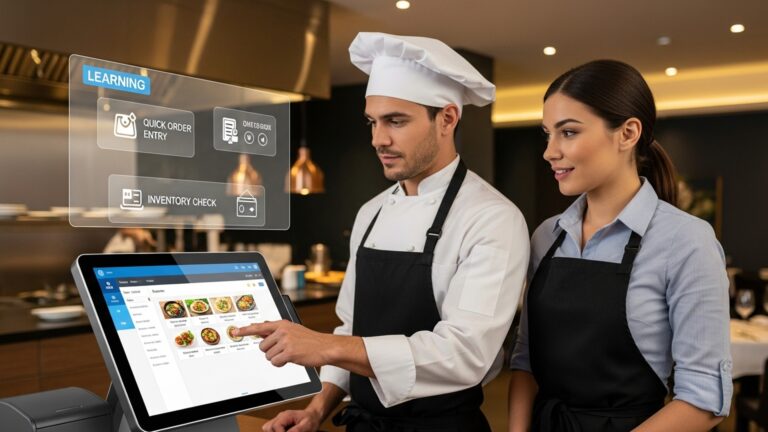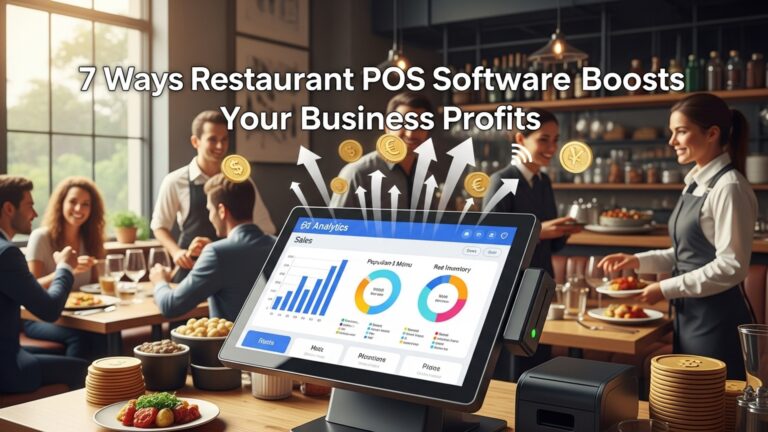How to Choose Essential Restaurant POS System Features for Your Business
The modern restaurant landscape demands more than just a basic cash register; it requires a strategic operational hub. With the rapid evolution of digital ordering, contactless payments. third-party delivery platform integration, selecting the right restaurant point of sale system features is paramount for sustained success. Forward-thinking establishments now prioritize advanced capabilities such as real-time inventory management to minimize waste, integrated kitchen display systems (KDS) for optimized workflow. AI-powered analytics to fine-tune menu pricing and staffing. The recent acceleration towards cloud-based mobile POS solutions further empowers operators, enhancing table service efficiency and streamlining online order fulfillment, ultimately boosting profitability and ensuring superior guest experiences in today’s dynamic market.
Understanding the Core of Your Restaurant’s Operations: The POS System
In the bustling world of hospitality, a Restaurant Point of Sale (POS) system is far more than just a cash register. It’s the central nervous system of your establishment, managing everything from taking orders and processing payments to tracking inventory and analyzing sales data. At its core, a POS system is a computerized network that allows businesses to perform sales transactions and process payments. For restaurants, this translates into a powerful tool designed to streamline operations, enhance customer experiences. ultimately, boost profitability.
Choosing the right restaurant point of sale system features is paramount because it directly impacts efficiency, accuracy. your ability to adapt to market demands. A well-selected system can reduce manual errors, speed up service, provide invaluable insights into your business’s performance. free up staff to focus on guest satisfaction. Conversely, a poorly chosen system with inadequate features can create bottlenecks, frustrate staff. deter customers, costing your business significant time and money.
Front-of-House (FOH) Restaurant Point of Sale System Features
The FOH features are what your servers and customers interact with most directly, focusing on order taking, service delivery. customer engagement.
- Intuitive Order Management
- Table Management
- Customizable Modifiers
- Split Checks & Item Transfers
- Course Management
- Customer Relationship Management (CRM) Tools
- Loyalty Programs
- Customer Feedback Integration
- Reporting & Analytics (Basic FOH)
- Sales by Server
- Popular Items
- Robust Inventory Management
- Real-time Tracking
- Recipe Management
- Vendor Management & Ordering
- Waste Tracking
- Employee Management
- Time Clock Integration
- Shift Scheduling
- Performance Tracking
- Kitchen Display Systems (KDS) Integration
- Order Routing
- Timers & Status Updates
- Accuracy
- Integrated Payment Processing
- Speed & Accuracy
- Simplified Reconciliation
- Reduced PCI Scope
- EMV & NFC Compliance
- EMV (Europay, MasterCard. Visa)
- NFC (Near Field Communication)
- PCI Data Security Standard (PCI DSS) Compliance
- Gift Card and Loyalty Program Integration
- Online Ordering & Delivery Integration
- Native Online Ordering
- Third-Party Delivery Platform Integration
- Multi-Location Management
- Centralized Reporting
- Centralized Menu Management
- Inventory Transfers
- Open API and Third-Party Integrations
- Accounting Software Integration
- Reservations Systems
- Payroll Services
- Marketing Automation
This is the backbone of FOH operations. Essential capabilities include:
A visual layout of your restaurant that allows staff to assign orders to tables, track their status (e. g. , seated, ordered, eating, paid). easily transfer checks. This feature is crucial for managing seating capacity and server sections efficiently.
The ability to quickly add special requests (e”no onions,” “extra cheese,” “medium-rare”) to orders. A well-designed system allows for pre-set modifiers and custom notes, minimizing kitchen errors and ensuring customer satisfaction. For example, a server might select “Burger” then add “Temp: Medium Rare” and “Add: Bacon.”
Seamlessly dividing a bill among multiple diners or transferring individual items between checks. This prevents end-of-meal friction and speeds up checkout.
For fine dining or multi-course meals, this feature allows servers to “fire” courses to the kitchen at the appropriate time, ensuring dishes arrive fresh and in sequence.
Building loyalty is key to repeat business.
Automatically track customer purchases, award points. manage redemptions for discounts or free items. This encourages repeat visits.
Some advanced systems can prompt customers for feedback directly after a transaction or integrate with review platforms, providing valuable insights for improvement.
While comprehensive analytics are BOH, FOH staff benefit from immediate access to:
Helps track individual performance and identify training needs.
Quick insights into what’s selling well, useful for upselling or daily specials.
Real-world application: Imagine a bustling Friday night. A server uses the table management feature to see which tables are open, quickly takes an order with multiple modifiers for a complex dish. then effortlessly splits the check between four friends at the end of the meal. This smooth workflow is a direct result of robust FOH restaurant point of sale system features.
Back-of-House (BOH) Restaurant Point of Sale System Features
BOH restaurant point of sale system features are designed to optimize behind-the-scenes operations, ensuring efficiency, cost control. seamless communication between the kitchen and management.
This is critical for controlling food costs and minimizing waste.
Monitor ingredient levels as items are sold, triggering alerts when stock is low. This prevents “86-ing” popular menu items.
Input recipes with exact ingredient quantities. When a dish is sold, the system automatically deducts the necessary ingredients from inventory. This is invaluable for accurate cost calculation and portion control.
Maintain a database of suppliers, track purchase orders. even automate reordering based on par levels.
Record spoiled or wasted ingredients, providing data to identify problem areas and improve operational practices.
Streamlining staff operations.
Employees clock in and out directly through the POS, ensuring accurate payroll.
Some systems offer basic scheduling tools, allowing managers to create and manage shifts. communicate schedules to staff.
Monitor sales by employee, tips. other metrics to assess performance and inform decisions.
A digital alternative to paper tickets.
Orders taken at the POS are instantly displayed on kitchen screens, often routed to specific stations (e. g. , grill, fry, prep).
Dishes can be marked as “in progress” or “completed,” helping the kitchen manage workflow and ensuring timely delivery.
Eliminates handwriting errors and lost tickets, improving order accuracy and speed.
Case Study Snippet: “Before implementing a POS with integrated inventory, our food costs were erratic,” shares Maria, owner of ‘The Daily Grind’ cafe. “We’d often run out of our best-selling avocado, or have too much lettuce spoil. Now, with real-time tracking and recipe management, our waste is down 15%. we haven’t ’86-ed an item in months. This single feature has saved us thousands annually.” This highlights the tangible benefits of strong BOH restaurant point of sale system features.
Payment Processing and Security: Non-Negotiable Restaurant Point of Sale System Features
Secure and efficient payment processing is fundamental to any POS system. Without it, your business can’t operate.
This means your POS system and payment processor are seamlessly connected.
Transactions are processed faster, reducing lines and manual errors.
Sales data and payment data automatically sync, making end-of-day reconciliation much easier and less prone to mistakes.
A well-integrated system can reduce your PCI (Payment Card Industry) compliance burden by ensuring sensitive card data is handled securely.
These are industry standards for secure payment.
Refers to chip cards. EMV-compliant terminals read the chip, encrypting data at the point of interaction, significantly reducing fraud liability for merchants.
Enables contactless payments (e. g. , Apple Pay, Google Pay). This offers speed and convenience, appealing to modern customers.
A set of security standards designed to ensure that all companies that accept, process, store, or transmit credit card details maintain a secure environment. Your chosen POS and payment processor must be PCI compliant to protect both your business and your customers’ sensitive data.
The ability to sell, redeem. manage digital and physical gift cards directly through the POS, often tied into loyalty programs. This is a powerful revenue generator and customer retention tool.
Actionable Takeaway: When evaluating restaurant point of sale system features, always prioritize systems that offer robust, integrated payment processing with EMV and NFC capabilities. clear documentation of their PCI compliance. This protects your business from fraud and provides customers with modern, secure payment options.
Advanced and Niche Restaurant Point of Sale System Features for Growth
Beyond the essentials, certain advanced features can significantly expand your restaurant’s reach and operational sophistication.
With the rise of digital convenience, this is increasingly vital.
Customers can place orders directly through your website or a dedicated app, feeding directly into your POS and KDS.
Seamlessly integrate with services like DoorDash, Uber Eats. Grubhub. This prevents manual re-entry of orders, reducing errors and saving staff time. Some systems can even manage menus across these platforms from a single dashboard.
For restaurants with more than one outlet, this feature is indispensable.
View sales, inventory. labor data across all locations from a single dashboard.
Update menus, pricing. promotions across all stores simultaneously, ensuring consistency.
Manage stock movement between locations.
An Application Programming Interface (API) allows different software systems to communicate with each other.
Automatically push sales data to platforms like QuickBooks or Xero, simplifying bookkeeping.
Connects with platforms like OpenTable or Resy for seamless table management.
Streamline employee data transfer for payroll processing.
Link customer data to email marketing platforms for targeted campaigns.
Example of an API integration concept:
// Pseudo-code for a POS system sending daily sales data to an accounting API function sendDailySalesToAccounting(date) { let dailySales = getSalesDataForDate(date); let accountingAPIEndpoint = "https://api. accountingsoftware. com/v1/sales"; let payload = { "date": date. toISOString(), "totalRevenue": dailySales. total, "taxCollected": dailySales. tax, "paymentsBreakdown": dailySales. payments }; fetch(accountingAPIEndpoint, { method: 'POST', headers: { 'Content-Type': 'application/json', 'Authorization': 'Bearer YOUR_API_KEY' }, body: JSON. stringify(payload) }). then(response => response. json()). then(data => console. log("Sales data sent to accounting:", data)). catch(error => console. error("Error sending sales data:", error)); }
This illustrates how an open API enables automated data transfer, saving countless hours of manual data entry and reducing errors.
Evaluating and Choosing the Right Restaurant Point of Sale System Features for Your Business
Selecting the ideal POS system requires careful consideration of several factors beyond just the feature list.
- Scalability
- User-Friendliness
- Reliable Support
- Pricing Models
- Subscription Fees
- Hardware Costs
- Payment Processing Fees
- Installation & Training Costs
- Compatibility & Hardware
Can the system grow with your business? If you plan to expand, add new services (e. g. , catering, delivery), or open more locations, your POS should be able to accommodate these changes without requiring a complete overhaul.
An intuitive interface reduces training time for new staff and minimizes operational errors. Conduct demos with your team to gauge ease of use. A system that’s difficult to navigate will slow down service and frustrate employees.
What kind of customer support does the provider offer? Look for 24/7 support, multiple contact methods (phone, email, chat). a strong knowledge base. Downtime due to a POS issue can be disastrous for a restaurant, so responsive support is critical.
grasp the total cost of ownership.
Most modern cloud-based POS systems charge monthly or annual fees per terminal or location.
Tablets, cash drawers, receipt printers, KDS screens – these can be purchased outright or leased.
grasp transaction rates, interchange fees. any hidden charges. Transparency is key here.
Some providers include these, others charge extra.
Ensure the system is compatible with your existing hardware or that the new hardware requirements fit your budget and setup. Many modern POS systems run on iPads or Android tablets, offering flexibility.
To help you prioritize, consider this comparison of feature criticality based on restaurant type:
| Feature Category | Café/Quick Service | Casual Dining | Fine Dining | Multi-Location Chain |
|---|---|---|---|---|
| Order Management (Speed & Modifiers) | Critical | Critical | Critical | Critical |
| Table Management | Less Critical | Critical | Critical | Critical |
| Inventory Management | essential | Critical | Critical | Critical |
| KDS Integration | essential | Critical | Critical | Critical |
| Loyalty Programs | Critical | vital | Less Critical | Critical |
| Online Ordering & Delivery | Critical | crucial | Less Critical | Critical |
| Multi-Location Management | Not Applicable | Not Applicable | Not Applicable | Critical |
| Advanced Reporting & Analytics | vital | Critical | Critical | Critical |
Real-World Impact: Case Studies and Actionable Takeaways
The right restaurant point of sale system features can be transformative.
Case Study: “After years of struggling with an outdated legacy system, we switched to a cloud-based POS with integrated online ordering and inventory,” says David Chen, owner of ‘Sizzle & Spice Grill’. “Our online sales jumped 30% in the first quarter because customers found it so easy to order. Plus, our kitchen staff loves the KDS; order accuracy is up. ticket times are down. The initial investment felt big. the ROI has been phenomenal, allowing us to expand our catering arm.”
- Identify Your Core Pain Points
- Map Out Your Workflow
- Future-Proof Your Choice
- Get Stakeholder Input
- Request Comprehensive Demos
- interpret the Ecosystem
What are your biggest operational challenges right now? Long lines? Food waste? Inaccurate orders? Prioritize restaurant point of sale system features that directly address these issues.
Visualize how each transaction, from order to payment, flows through your restaurant. This helps identify where a POS can provide the most value.
Don’t just pick features for today. Consider your growth plans for the next 3-5 years. Will the system support new menu items, additional locations, or an increased focus on delivery?
Involve your front-of-house staff, kitchen managers. even your accountant in the decision-making process. They are the ones who will use the system daily and can provide valuable insights into necessary restaurant point of sale system features.
Don’t settle for a basic overview. Ask for in-depth demonstrations of the specific features crucial to you. ideally, a trial period to test the system in your actual environment.
A POS is rarely a standalone solution. Consider its ability to integrate with other essential tools you use or plan to use (accounting, marketing, reservations).
By taking a strategic, feature-by-feature approach, you can select a restaurant point of sale system that not only meets your current needs but also empowers your business for future success.
Conclusion
Choosing the essential POS system features for your restaurant isn’t merely a technical decision; it’s a strategic investment in your business’s future. You must look beyond a checklist of functions and instead identify capabilities that directly solve operational challenges and amplify customer satisfaction. For instance, a bustling cafe might prioritize rapid order entry and integrated payment processing, while a fine dining establishment would benefit immensely from advanced table management and reservation systems. From my experience, the true value emerges when features like integrated online ordering, contactless QR code payments. robust inventory management work seamlessly together, providing actionable data insights rather than just raw numbers. This holistic approach, embracing current trends like cloud-based flexibility and AI-driven analytics, transforms your POS from a simple transaction tool into a powerful engine for growth. Don’t just settle for what’s available; actively seek a system that scales with your ambition, empowering you to innovate, optimize. consistently exceed customer expectations. Embrace this choice as an opportunity to future-proof your restaurant and unlock its full potential.
More Articles
Avoid These 6 Common Mistakes When Using Restaurant POS Solutions
5 Smart Ways Restaurant POS Software Boosts Your Business Profits
How to Choose the Best Restaurant POS System 7 Essential Tips
Learn 6 Simple Steps to Master Restaurant POS Inventory Management
6 Ways Restaurant POS Improves Customer Service and Efficiency
FAQs
Where do I even begin when looking for POS features?
Start by understanding your specific restaurant type and daily operations. Are you a quick-service spot, a cozy cafe, fine dining, or a bustling bar? Each has unique needs. Pinpoint your biggest operational headaches first, whether it’s long queues, complex orders, or inventory woes. prioritize features that solve those.
What essential features help with taking and managing orders efficiently?
For seamless order management, look for intuitive order entry, table management (if you have tables!) , easy split billing, modifiers for custom orders. seamless integration with a Kitchen Display System (KDS). Online ordering integration is also crucial for many businesses today.
How crucial is payment processing. what options should I look for?
It’s super crucial! You need secure, fast. flexible payment processing. Ensure the system supports various payment types like credit cards, mobile payments (Apple Pay, Google Pay). gift cards. Integrations with your preferred payment processor and the ability to process payments at the table can also be huge time-savers.
Can a POS system actually help me manage my ingredients and control costs?
Absolutely! Robust inventory management features let you track ingredients in real-time, monitor stock levels, manage recipes. even set up alerts for low stock. This functionality helps reduce waste, control food costs. streamline ordering from suppliers, directly impacting your bottom line.
What kind of data and reports should a good POS provide?
A strong system offers comprehensive reporting. You’ll want detailed sales reports (by item, category, or time of day), labor cost analysis, employee performance tracking. insights into peak hours. This data is invaluable for making informed business decisions, optimizing staffing. identifying your most popular menu items.
How can a POS system help me keep customers coming back for more?
Look for features that support customer relationship management (CRM). This could include built-in loyalty programs, the ability to collect customer data (always with their consent!). even integration with marketing tools for targeted promotions. Happy, returning customers are the lifeblood of any restaurant.
What about future growth and getting help if something goes wrong?
Choose a system that’s scalable, meaning it can easily expand with your business without needing a complete overhaul. Also, prioritize reliable customer support—24/7 assistance is often ideal for restaurants that operate long hours. Consider cloud-based systems for easier updates and remote access to your data.




